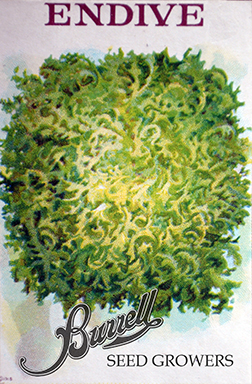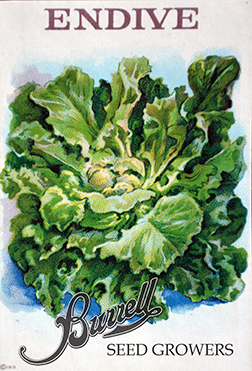Growing Endive and Escarole.
Endive is the ingredient that gives Italian Wedding soup its’ signature flavor. This slightly bitter green adds a richness to the broth that is unmistakeable. Not the insulting, canned, grocery store variety, but the decadent soup served at traditional Italian weddings. The kind grandma Ruffino made. Mmmm. Try adding chopped endive to your chicken soup.
Escarole or Broadleaf Batavian Endive is a lesser known green. Packed with nutrition, escarole can be sautéd with olive oil, garlic and a sprinkle of crushed red pepper. Braised with chunks of ham and beans or added to soups, this cool weather green is a delicacy worthy of a grow.
Knowledgeable gardeners will blanch their endive. This process limits chlorophyll production and lessens the bitter flavor. You can accomplish this two different ways. Tie the outermost leaves together on top of the plant to cover the heart or cover with a flower pot. Either way, leave covered for two to three weeks, remembering to water during this final phase. Harvest and enjoy.
For an early-summer crop, start endive seeds indoors in flats 2 months before the last frost date. Transplant outdoors 6 to 8 weeks later, giving each plant 1 foot all around. For a fall crop, direct seed outdoors around the first of July or approximately 90 days before the first fall frost.Both escarole and endive prefer humus rich soil. Don’t skimp on water. Drought conditions make these greens too bitter.
Good companion crops are mizuna and mustard.
Growing Endive and Escarole.
Endive is the ingredient that gives Italian Wedding soup its’ signature flavor. This slightly bitter green adds a richness to the broth that is unmistakeable. Not the insulting, canned, grocery store variety, but the decadent soup served at traditional Italian weddings. The kind grandma Ruffino made. Mmmm. Try adding chopped endive to your chicken soup.
Escarole or Broadleaf Batavian Endive is a lesser known green. Packed with nutrition, escarole can be sautéd with olive oil, garlic and a sprinkle of crushed red pepper. Braised with chunks of ham and beans or added to soups, this cool weather green is a delicacy worthy of a grow.
Knowledgeable gardeners will blanch their endive. This process limits chlorophyll production and lessens the bitter flavor. You can accomplish this two different ways. Tie the outermost leaves together on top of the plant to cover the heart or cover with a flower pot. Either way, leave covered for two to three weeks, remembering to water during this final phase. Harvest and enjoy.
For an early-summer crop, start endive seeds indoors in flats 2 months before the last frost date. Transplant outdoors 6 to 8 weeks later, giving each plant 1 foot all around. For a fall crop, direct seed outdoors around the first of July or approximately 90 days before the first fall frost.Both escarole and endive prefer humus rich soil. Don’t skimp on water. Drought conditions make these greens too bitter.
Good companion crops are mizuna and mustard.



